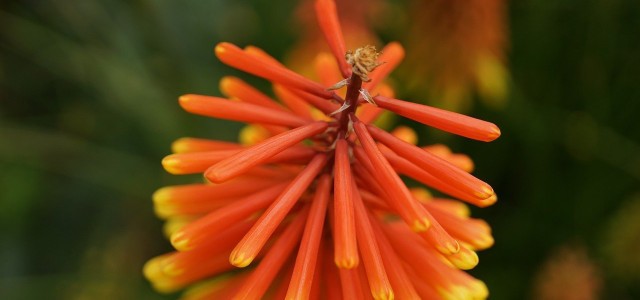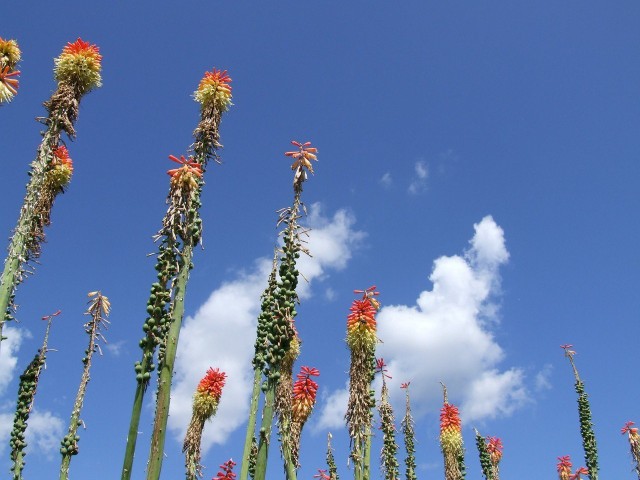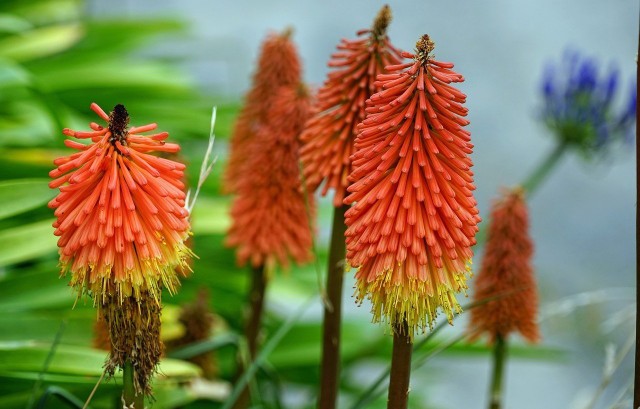
Torch lilies are tall perennials with bright, yellow-red flowers that resemble torches. How to plant and care for the rocket flower in the garden, you will learn here.
Torch lilies look a bit unusual, but that’s what makes them special: the perennial grows between 80 and 160 centimeters tall and stands out with intense colors. Their yellow-red flowers are visually reminiscent of small torches. Depending on the variety, the color palette ranges from bright red and orange to yellow and greenish white. The torch lily, also called rocket flower, blooms from June to October. Depending on the variety, flowering may start a little earlier or later: For example, the Grandiflori variety blooms earlier, and the Evening Star variety blooms later. Torch lilies also do well as cut flowers in bouquets with their vibrant colors and are among the longer-lasting cut plants. Also important for parents and pet owners: Torch lily is not poisonous.
Plant torch lily

- Timing: You can plant the torch lily in the spring after the icemen. The best time to do this is mid-May.
- Location: Choose a location that is as sunny and warm as possible. It should also be protected from the wind. Originally, the torch lily comes from South Africa, so it loves warmth.
- Soil: The soil should be humus-rich and nutrient-rich. To ensure this, you can mix nutrients into the soil in the form of humus or compost. To make the soil well-drained and loose, you can add sand or gravel.
- Sowing: Do not sow torch lilies directly outdoors. You can sow purchased seeds directly into small growing containers with growing soil or potting soil. Always keep the soil moist, but not wet. On the windowsill, with a little sun, the seeds can germinate and young plants can thrive over the next two to four weeks. However, you should protect the young plants from blazing midday sun. When the first leaves have formed, you can plant them outside in mid-May. Sowing is always possible. However, it is best to start at the end of winter, as the young plants need a few weeks before they are ready for transplanting. Note that the new plant may take two or three years before it delights you with its first bloom.
- Planting seedlings: Dig a hole about eight to ten inches deep in the bed for a young plant. Place it in the center, fill in the soil again and press everything down well. Then water the torch lily well.
- Neighbors: Since the torch lily grows quite tall, you can combine it with other tall perennials or grasses. Plants such as lilies, catmint, sage or baby’s breath do well in a perennial bed. You can also leave the torch lily alone in the garden.
Care for torch lily

The torch lily is extremely easy to care for. Nevertheless, follow our tips so that you can enjoy the plant and its flowers for as long as possible.
- Watering: During the summer months, you should water daily, preferably in the morning or evening. On very hot days, it is worth watering the torch lily twice a day. Be careful not to douse the flowers with water, but water only the roots if possible. Avoid waterlogging, as it can lead to root rot. Overall, you should water regularly and in moderation.
- Fertilize: From May to August, you should fertilize again and again. It is best to use an organic fertilizer such as compost or horn shavings. After pruning in spring, you should also fertilize.
- Pruning: You do not need to cut back the torch lily until spring. You should then cut back all stems close to the ground (about a hand’s width from the ground). A little fertilizer will help the plant to grow vigorously. During the rest of the year you can remove withered flowers regularly. You can also cut down withered stems with pruning shears. This will give the plant the strength to grow new stems and flowers. Maybe you can enjoy a longer flowering. Only if you want to harvest the seeds in the fall, you should leave the flowers.
- Propagate by seed: You can collect seeds for the propagation of the torch lily from the withered inflorescences; the capsule fruits with the seeds ripen in these. Fill the collected seeds into a sealable container and put it in the refrigerator. It is best to mix the seeds with some moist sand. After about six weeks they are ready to be planted in potting soil and containers. Moisten the soil slightly and sprinkle the seeds on top. Continue as described above in the section “Planting torch lily”.
- Propagation by division: Another way of propagation is division. The best time to do this is after pruning in the spring. Dig up the plant and divide the root with a sharp spade. Then put the plant back again, the divided root you can now plant in another location. By the way: The torch lily also reproduces itself. If you want to avoid independent propagation, you should remove withered inflorescences immediately so that the seeds cannot mature in them.
- Hibernation: Torch lilies do not like the cold wet winter weather very much. They are considered conditionally hardy, but there are differences in frost sensitivity depending on the variety. You can leave torch lilies outside if you wrap them well with heat-retaining and breathable fabric. Suitable are for example jute or fleece. You can tie the leaves with sisal or other tape and then wrap the plant with the fabric. The area around the roots can be covered with leaves or bark mulch. Watering and fertilizing is not necessary in winter. Alternatively, you can bring the torch lily indoors to protect it from frost. If you have it in the bed, you can temporarily transplant it into a large enough container for this purpose.
- Diseases and pests: Diseases are usually not a problem for the torch lily, as it is quite hardy. However, pests such as slugs or lily fleas are happy visitors to the perennial.

